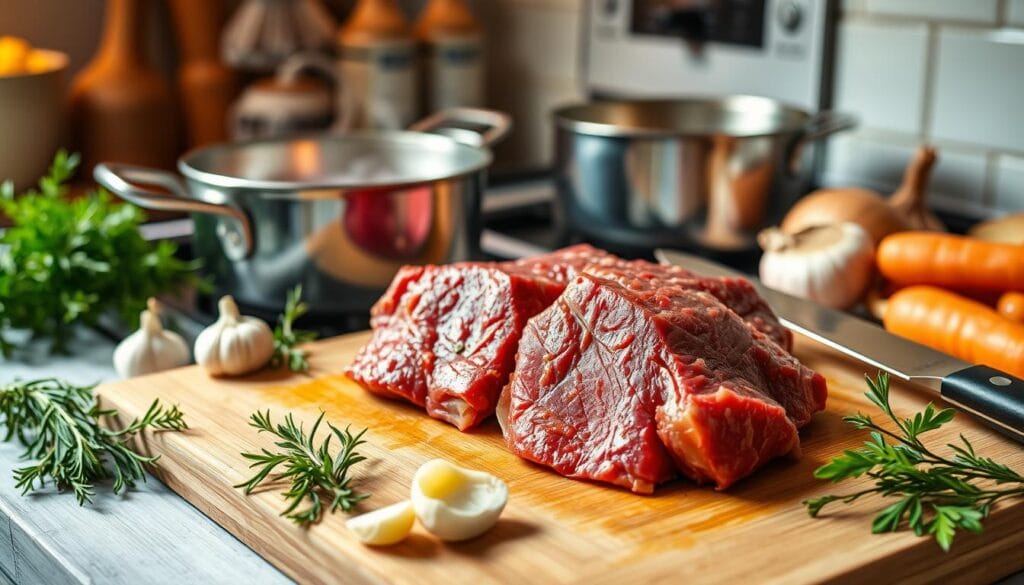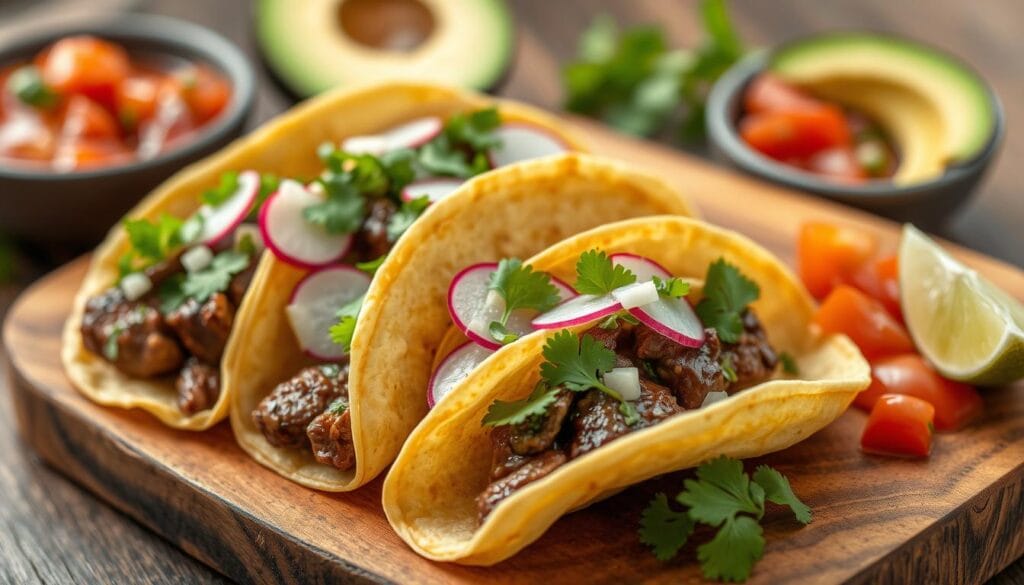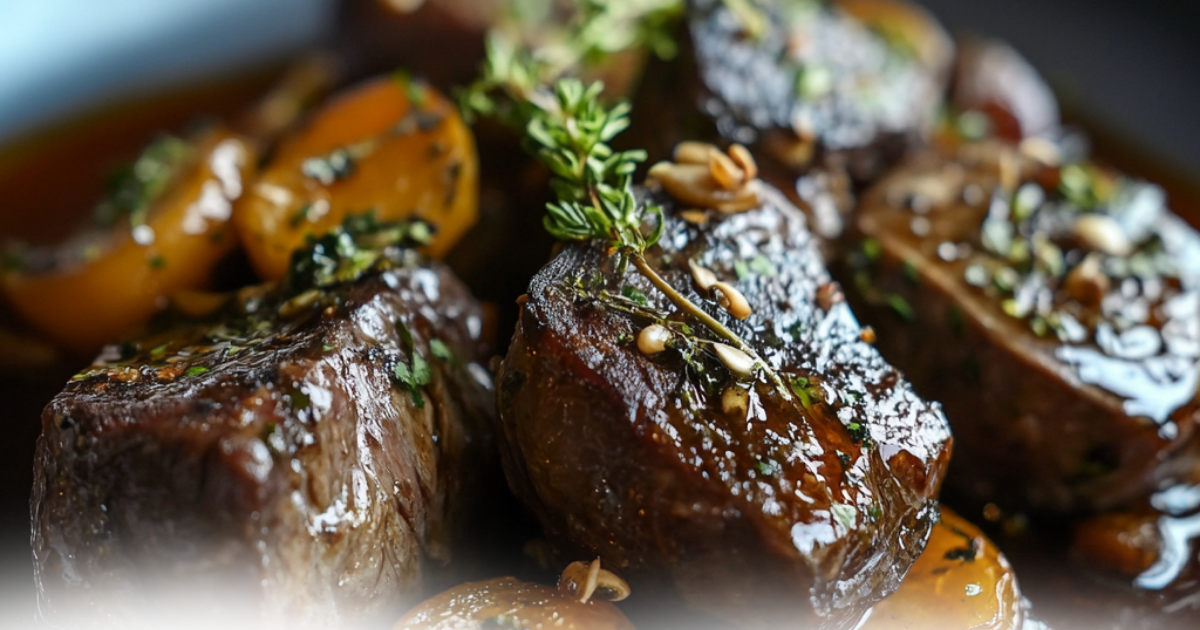Beef cheek is one of the secret gem when cooking. It transforms from hard to soft and delicious when you do the right preparation. Chefs and cooks alike appreciate it for creating top quality recipes.
The preparation of beef cheek meat requires patience and the right techniques. It will reveal its delicious flavor and soft texture. It doesn’t matter if you’re a home cook or an avid foodie and want to learn how to cook soft beef cheeks is sure to improve your cooking skills and amaze your guests.
Knowing how beef cheek meat works is key to success. This guide will show you the best techniques, tools, and recipes. You’ll learn how to turn this tough cut into a tender, delicious meal.
In this detailed article, you’ll get step-by-step tips for choosing, preparing, and cooking beef cheeks. You’ll explore traditional Spanish recipes and modern cooking methods. You’ll learn how to make restaurant-quality dishes in your own kitchen.
Table of contents
Understanding Beef Cheek Meat: A Hidden Culinary Treasure
Beef cheek meat is often overlooked in cooking. Yet, it offers a rich taste experience that chefs and home cooks are starting to explore. So, what exactly is beef cheek? It’s a tough but flavorful muscle from a cow’s face.

Origins and Anatomical Location
Where does beef cheek meat come from? It comes from the cow’s facial muscles. These muscles are very dense because they move a lot while the cow grazes and chews. This makes the meat tough but full of flavor.
- Located in the cow’s facial muscle region
- Develops significant muscle density through constant movement
- Requires specialized cooking techniques to become tender
Nutritional Benefits and Composition
Is beef cheek a good cut of meat? Yes, it is! It’s full of protein, minerals, and flavor. Its high collagen content is perfect for slow cooking, making it tender and delicious.
Why Chefs Love This Cut
“Beef cheeks represent the perfect combination of flavor intensity and potential for transformation through cooking techniques.” – Renowned Chef Michael Roberts
Chefs love beef cheeks for their rich flavor and versatility. When cooked right, this cut turns into a gourmet treat. It’s a simple ingredient that can become a culinary masterpiece.
| Nutritional Aspect | Value per 100g |
|---|---|
| Protein | 26g |
| Fat | 8g |
| Iron | 2.5mg |
Essential Equipment for Cooking Beef Cheeks
Mastering beef cheek preparation needs the right kitchen tools. The right equipment can make your cooking better and ensure tender, tasty results. Let’s look at the essential tools for making restaurant-quality beef cheeks at home.
“The right tool makes all the difference in cooking beef cheeks.” – Professional Chef
For cooking beef cheeks well, you’ll need several key tools:
- Slow Cooker: Perfect for breaking down tough meat fibers
- Dutch Oven: Ideal for braising and achieving rich flavors
- Pressure Cooker: Reduces cooking time dramatically
- Sharp Trimming Knife: Essential for beef cheek preparation
- Meat Thermometer: Ensures precise doneness
Each tool is important for beef cheek preparation. A digital meat thermometer helps you check the internal temperature, avoiding overcooking. The slow cooker cooks the meat slowly, making it very tender.
Professional chefs say to invest in quality kitchen tools. A heavy-bottomed Dutch oven cooks evenly, perfect for braising beef cheeks. Pressure cookers cut cooking time from hours to minutes, keeping the flavor and tenderness great.
Pro Tip: Choose multi-functional cookware to make your kitchen more efficient when preparing beef cheeks.
Preparing Beef Cheeks for Cooking
Mastering beef cheek preparation is all about detail and technique. It turns a tough cut into a tender treat. Knowing the right steps can make your cooking stand out.
Cleaning and Trimming Techniques
First, clean the beef cheeks well. Remove any extra fat and silver skin. Use a sharp knife to trim off connective tissues carefully. This makes the meat ready to soak up flavors and cook evenly.
- Remove external fat layers
- Trim visible silver skin
- Cut into uniform pieces
- Pat dry with paper towels
Proper Seasoning Methods
Seasoning beef cheeks needs thought. The meat’s strong flavor calls for bold spices. Mix spices that boost the meat’s taste without overpowering it.
| Seasoning Category | Recommended Spices | Flavor Profile |
|---|---|---|
| Classic | Salt, Black Pepper, Garlic Powder | Traditional, Balanced |
| Spanish-Inspired | Smoked Paprika, Cumin, Oregano | Intense, Complex |
| Herb-Based | Thyme, Rosemary, Bay Leaf | Earthy, Aromatic |
Marination Tips and Timing
Marinating beef cheeks tenderizes the meat and adds flavor. Marinate for 4 to 12 hours, depending on the ingredients.
“The secret to perfect beef cheeks is patience during marination.” – Professional Chef
- Use acidic ingredients like wine or vinegar
- Include olive oil for moisture
- Refrigerate during marination
- Turn meat occasionally for even coating
By using these techniques, you can turn tough beef cheeks into a dish that wows everyone.
Best Cooking Methods for Tender Beef Cheek Meat
To make beef cheek meat tender, you need special cooking methods. These cuts are tough because they’re used a lot. So, getting them just right is key for a tender dish.

- Braising: Slow-cooking in liquid at low temperatures
- Pressure cooking: Rapid tenderization under high pressure
- Slow cooker: Extended gentle heating
- Sous vide: Precise temperature-controlled cooking
Braising is the classic way to tenderize beef cheeks. First, sear the meat. Then, cook it slowly in tasty liquid for hours.
“The key to tender beef cheeks is patience and low, consistent heat,” says renowned chef Mario Rodriguez.
| Cooking Method | Average Cooking Time | Tenderness Level |
|---|---|---|
| Braising | 3-4 hours | Extremely Tender |
| Pressure Cooking | 45-60 minutes | Very Tender |
| Slow Cooker | 6-8 hours | Melt-in-Mouth Tender |
| Sous Vide | 24-36 hours | Perfectly Tender |
Understanding beef cheeks’ unique makeup is crucial. The collagen in them breaks down slowly. This makes the meat tender and flavorful when cooked right.
Traditional Spanish Beef Cheek Recipes
Spanish cuisine makes beef cheek meat into a true masterpiece. It uses slow-cooking to bring out amazing flavors. This method is a key part of Spanish cooking.
Spanish beef cheek recipes show how versatile this meat is. They highlight why it’s so loved in Spanish cooking. These dishes have been perfected over many years.
Carrilladas al Vino Tinto: A Classic Spanish Delicacy
Carrilladas al Vino Tinto is the top dish made with beef cheek in Spain. It’s cooked slowly in red wine. This makes the meat incredibly tender and flavorful.
- Red wine braising technique
- Tender, falling-apart meat texture
- Rich, complex flavor profile
Braised Beef Cheeks with Garlic
Braising beef cheek meat with garlic is another favorite. It makes the meat very tender and rich. This dish shows off the meat’s natural taste.
Traditional Seasonings and Spices
Spanish chefs use special spices to season beef cheek meat. These spices make the meat even more delicious. The main ingredients are:
- Smoked paprika
- Fresh garlic
- Bay leaves
- Olive oil
- Black pepper
“The magic of Spanish beef cheek recipes lies in patience and understanding the meat’s unique characteristics.” – Spanish Culinary Experts
When cooking beef cheek meat Spanish style, slow cooking is key. It makes the meat tender and full of flavor. This method is essential for great results.
Creating Restaurant-Style Beef Cheek Tacos

To make beef cheek meat tacos like a pro, you need skill and passion. Mexican-inspired beef cheeks make your tacos tender and rich. This takes your taco game to the next level.
Choose the best beef cheek meat for your tacos. The secret to amazing tacos is in how you prepare and season the meat. You want your tacos to be so tender, they melt in your mouth, just like in top Mexican restaurants.
Preparation Techniques
- Slow-cook beef cheeks until incredibly tender
- Shred meat using two forks for perfect texture
- Season generously with authentic Mexican spices
When you assemble your tacos, think about the flavors. Use traditional corn tortillas to show off the rich beef cheek meat.
Recommended Toppings
- Fresh cilantro
- Diced white onions
- Lime wedges
- Homemade salsa
“The secret to great tacos is balancing complex flavors with simple, fresh ingredients.” – Chef Maria Rodriguez
Pro tip: Let your beef cheeks rest after cooking for tenderness. Warm your tortillas on a griddle to add flavor and flexibility.
Master these techniques, and you’ll create beef cheek meat tacos that transport your taste buds straight to Mexico’s vibrant culinary landscape.
Slow Cooker Beef Cheek Techniques
Mastering slow cooker beef cheeks needs patience and precision. This method turns tough meat into a tender, melt-in-your-mouth dish. It will wow even the pickiest home cooks.
Optimal Temperature Control
Temperature control is key when cooking beef cheeks in a slow cooker. Set it to low heat, around 190-200°F. This slow cooking breaks down tough tissues, making the meat tender and easy to shred.
Cooking Time and Doneness
The cooking time for beef cheeks depends on their size and how tender you want them. Here’s a general guide:
- 4-6 hours for tender, pull-apart meat
- 6-8 hours for maximum tenderness
- Avoid cooking over 8 hours to prevent dryness
Liquid Ratios and Flavor Boosters
To get perfect beef cheek doneness, follow these liquid ratio tips:
- Use enough liquid to cover 2/3 of the meat
- Choose flavorful liquids like red wine, beef broth, or tomato-based sauces
- Add aromatics such as garlic, onions, and herbs
“Low and slow is the secret to transforming tough beef cheeks into a culinary masterpiece.” – Professional Chef
Pro tip: Check the internal temperature of your beef cheeks. They’re perfectly done when they reach 195-205°F. This ensures they are tender and full of flavor.
Common Mistakes to Avoid When Cooking Beef Cheeks
Cooking beef cheeks can be tricky. But knowing common mistakes helps you master this delicious cut. Many home cooks struggle, but with the right techniques, you can get restaurant-quality results.
- Improper Trimming: Always remove excess fat and silver skin before cooking. Leaving too much connective tissue can result in tough, chewy meat.
- Insufficient Braising Liquid: Beef cheeks need plenty of moisture. Skimp on liquid, and you’ll get dry, stringy meat instead of tender, melt-in-your-mouth goodness.
- Rushing the Cooking Process: These cuts demand patience. Low and slow is the golden rule for achieving maximum tenderness.
“Beef cheeks are a delicate cut that rewards careful preparation and patience.” – Professional Chef
Temperature control is crucial when cooking beef cheeks. Cooking at too high a temperature can quickly turn your potential masterpiece into a tough, stringy disaster. Aim for a consistent low temperature between 275-300°F when braising.
Seasoning is another critical aspect of beef cheek preparation. Under-seasoning can leave your dish bland, while over-seasoning can overpower the meat’s natural rich flavor. Use a balanced blend of herbs and spices that complement the beef’s deep, meaty taste.
By avoiding these common mistakes, you’ll transform beef cheeks from a challenging cut to a show-stopping meal that will impress even the most discerning diners.
Pairing and Serving Suggestions
To make your beef cheek meal special, choose the right wine and side dishes. Beef cheeks are tender and flavorful. They need the right foods to bring out their taste.
Perfect Wine Pairings for Beef Cheek Dishes
For wine, pick strong reds that match the meat’s bold flavor. Here are some great choices:
- Cabernet Sauvignon
- Malbec
- Syrah/Shiraz
- Bordeaux blends
Ideal Side Dishes for Beef Cheeks
Good side dishes can make your meal amazing. Try these options:
- Creamy polenta
- Roasted root vegetables
- Mashed cauliflower
- Garlic-herb risotto
| Wine Type | Flavor Profile | Best Serving Method |
|---|---|---|
| Cabernet Sauvignon | Full-bodied, tannic | Decant 1 hour before serving |
| Malbec | Fruity, smooth | Serve at room temperature |
| Syrah | Spicy, bold | Pair with herb-crusted beef cheeks |
Serving Beef Cheek Meat with Style
How you serve beef cheek meat is as important as its taste. Use warmed plates, garnish with fresh herbs, and add a drizzle of sauce for elegance.
Pro tip: Let your beef cheeks rest for 10-15 minutes after cooking to ensure maximum tenderness and flavor distribution.
By picking the right wines and side dishes, you’ll have a memorable meal. It will show off the amazing taste of beef cheek meat.
Storage and Reheating Tips
Storing cooked beef cheeks is key to keeping their flavor and tenderness. You need the right containers and follow temperature rules.
- Cool the meat completely before storing
- Use airtight containers or heavy-duty freezer bags
- Refrigerate within two hours of cooking
- Store in the refrigerator for up to 3-4 days
When reheating beef cheek meat, be gentle. High heat can dry it out.
Recommended Reheating Techniques
- Oven method:
- Preheat oven to 325°F
- Add a splash of broth or sauce
- Cover with foil to retain moisture
- Heat until internal temperature reaches 165°F
- Slow cooker method:
- Place meat in slow cooker
- Add small amount of liquid
- Heat on low for 2-3 hours
Freezing is great for long-term storage. Wrap the meat tightly in freezer-safe packaging to avoid freezer burn.
| Storage Method | Maximum Storage Time | Best Practices |
|---|---|---|
| Refrigerator | 3-4 days | Use airtight container, keep at 40°F or below |
| Freezer | 2-3 months | Wrap tightly, remove excess air from packaging |
“The key to perfect leftovers is gentle reheating and proper storage.” – Professional Chef’s Tip
Pro tip: Always label your containers with the date of storage to track freshness and ensure the best quality for your beef cheek meat leftovers.
Conclusion
Cooking beef cheeks at home can boost your cooking skills. It brings restaurant-quality dishes right to your kitchen. This unique cut offers deep flavors that many home cooks miss.
By following the techniques in this guide, you’ll make tender beef cheek dishes. These dishes will wow your family and friends.
Mastering beef cheek preparation takes patience and practice. Each cooking method, like slow braising or pressure cooking, has its own way of tenderizing the meat. Low and slow cooking is key for this flavorful cut.
Starting your beef cheek cooking journey opens up new culinary possibilities. You can make traditional Spanish dishes or try new fusion recipes. These meats are a great canvas for your creativity.
Start with the basics, build your confidence, and add your own twist to these recipes. With practice and passion, you’ll become an expert at making delicious beef cheek dishes. Enjoy every step of your cooking adventure.
FAQ
What exactly is beef cheek meat?
Beef cheek meat comes from the cow’s cheek area. It’s a tough muscle that gets tender when slow-cooked. Chefs love it for braising and stewing.
Is beef cheek a good cut of meat?
Yes, beef cheek is great when cooked right. It’s tough at first but becomes tender and flavorful with slow cooking. Its rich flavor and texture are loved in many dishes.
Where does beef cheek meat come from?
Beef cheek meat is from the cow’s facial muscles, especially the cheek. This muscle is always working, making the meat tough but full of flavor. It needs careful cooking to become tender.
What are some traditional ways to cook beef cheeks?
Traditional cooking for beef cheeks includes braising and slow cooking. Pressure cooking and Spanish-style methods like Carrilladas al Vino Tinto are also popular. These methods make the meat tender and flavorful.
Are beef cheeks good for tacos?
Beef cheek meat is perfect for tacos! Slow-cooked and shredded, it adds a rich flavor and tender texture. Many restaurants offer beef cheek tacos as a special dish.
How long does it typically take to cook beef cheeks?
Beef cheeks take 3-4 hours to cook, depending on the method. Braising or slow cooking at low temperatures breaks down the connective tissues. This makes the meat tender and delicious.
What are the nutritional benefits of beef cheek meat?
Beef cheek meat is packed with protein and essential amino acids. It also has iron and zinc. Plus, it’s full of collagen, which can be good for joints and skin.
Can I prepare beef cheeks in a slow cooker?
Yes, a slow cooker is perfect for beef cheeks. The low heat breaks down the muscle fibers, making the meat tender. Cooking on low for 6-8 hours is recommended for the best results.

